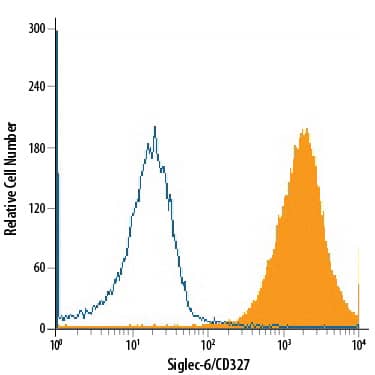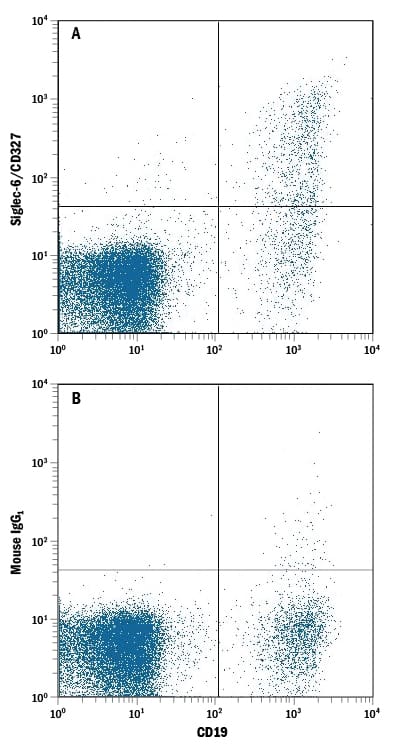Human Siglec-6/CD327 Antibody
R&D Systems, part of Bio-Techne | Catalog # MAB2859


Key Product Details
Species Reactivity
Validated:
Cited:
Applications
Validated:
Cited:
Label
Antibody Source
Product Specifications
Immunogen
Gln27-Ser331
Accession # O43699
Specificity
Clonality
Host
Isotype
Scientific Data Images for Human Siglec-6/CD327 Antibody
Detection of Siglec‑6/CD327 in U937 Human Cell Line by Flow Cytometry.
U937 human histiocytic lymphoma cell line was stained with Mouse Anti-Human Siglec-6/CD327 Monoclonal Antibody (Catalog # MAB2859, filled histogram) or isotype control antibody (Catalog # MAB003, open histogram), followed by Allophycocyanin-conjugated Anti-Mouse IgG Secondary Antibody (Catalog # F0101B).Detection of Siglec‑6/CD327 in Human PBMC lymphocytes by Flow Cytometry.
Human peripheral blood mononuclear cell (PBMC) lymphocytes were stained with Mouse Anti-Human CD19 APC-conjugated Monoclonal Antibody (Catalog # FAB4867A) and either (A) Mouse Anti-Human Siglec-6/CD327 Monoclonal Antibody (Catalog # MAB2859) or (B) Mouse IgG2AIsotype Control (Catalog # MAB003) followed by Phycoerythrin-conjugated Anti-Mouse IgG Secondary Antibody (Catalog # F0102B).Applications for Human Siglec-6/CD327 Antibody
CyTOF-ready
Flow Cytometry
Sample: U937 human histiocytic lymphoma cell line and human peripheral blood mononuclear cell (PBMC) lymphocytes
Formulation, Preparation, and Storage
Purification
Reconstitution
Formulation
Shipping
Stability & Storage
- 12 months from date of receipt, -20 to -70 °C as supplied.
- 1 month, 2 to 8 °C under sterile conditions after reconstitution.
- 6 months, -20 to -70 °C under sterile conditions after reconstitution.
Background: Siglec-6/CD327
Siglecs (Sialic acid binding Ig-like Lectins) are I-type (Ig-type) lectins that belong to the Ig superfamily. They are characterized by an N-terminal Ig-like V-type domain which mediates sialic acid binding, followed by varying numbers of Ig-like C2-type domains (1‑4). Eleven human Siglecs (Siglec-1 through 11) have been cloned and characterized. Within these eleven, there are at least two groups, one of which is termed the CD33-related group. CD33-related Siglecs include CD33/Siglec-3 and Siglec-5 through 11 (1, 3). To date, no Siglec has been shown to recognize any cell surface ligand other than sialic acid. This suggests that interactions with glycans containing this carbohydrate are important in mediating the biological functions of Siglecs. The cDNA of human Siglec-6 (also known as OB-BP1 and CD33L), encodes a putative 442 amino acid (aa) protein that contains a 15 aa signal peptide, a 321 aa extracellular region, a 21 aa transmembrane region (TM), and an 85 aa cytoplasmic tail (5, 6). The extracellular region contains one N-terminal V-type Ig-like domain followed by two Ig-like C2-type domains. The cytoplasmic domain has one immunoreceptor tyrosine-based inhibition motif (ITIM). At least three additional isoforms exist, all of which encode an additional 11 aa’s at the N-terminus, likely due to the utilization of an alternate start site. Two of the three isoforms also show splicing. One isoform shows a 16 aa in-frame deletion in the second C2-like domain, while the other shows a deletion of the TM and cytoplasmic region, thus potentially generating a soluble form (6‑9). Siglec-6 is found on B cells and in placenta, and would seem to have a restricted specificity for the sialyl Tn antigen (6, 10).
Long Name
Alternate Names
Entrez Gene IDs
Gene Symbol
UniProt
Additional Siglec-6/CD327 Products
Product Documents for Human Siglec-6/CD327 Antibody
Product Specific Notices for Human Siglec-6/CD327 Antibody
For research use only
